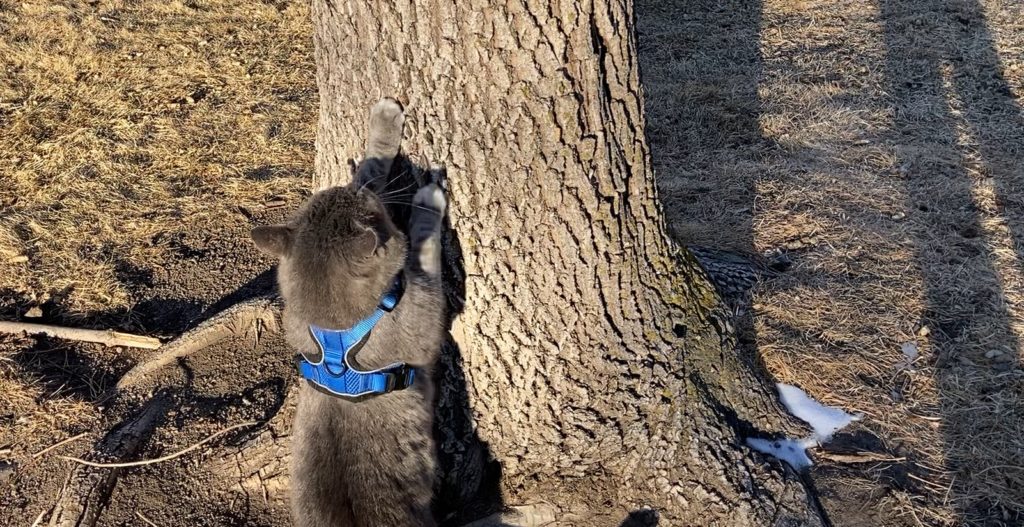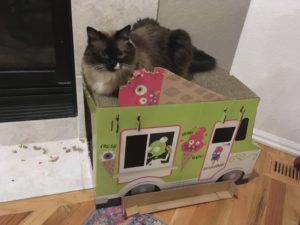
One of the topics I touch on in the first session of kitten kindergarten is providing kittens with a cat-friendly home, following the environmental requirements suggested by the International Society of Feline Medicine.
Five “Pillars” hold up a cat-friendly home. They are:
- multiple, separated resources (litter boxes, food, water, places to sleep)
- opportunity for predatory play – those toy mice are good for hunting practice!
- positive, consistent, and predictable human-cat interactions
- a place where the cat feels safe
- a place that respects the cat’s keen sense of smell
All cats scratch – it is normal for cats to scratch. Where does scratching fit into the cat-friendly home?
cats and scratching:why
To maintain their claws: Cats use their claws to hold mice and other prey; they also use their claws to defend themselves. Sharp claws work better for hunting and defense, so cats will often scratch on trees, logs or fence posts when outdoors to shed old claws and expose the new, sharp talons underneath.
To stretch: A scratching post provides a great place to stretch after a nap.
To communicate with other cats: As a cat scratches, glands in her feet release a pheromone. This chemical leaves a scent behind that lets other cats know who left the scratch marks and when. The scent accumulates over time and provides a reference point in the scent map the cat has of her home. She also finds her own scent and the scent of the cats from her social group comforting. We humans also find some scents soothing, like the smell of apple pie in the oven during the holidays, that gives you that “homey”, secure feeling.
Even cats who have been declawed will “scratch” on a post or pad, leaving a scent message behind.
If your cat passes the scratches and detects the scent from an unknown cat or one he doesn’t like, he will stop and take a careful sniff. He may stay away from this area so that he doesn’t encounter this unknown/unfriendly cat. Cats in the wild avoid fighting and injury in this way. Cats in multi-cat homes may avoid cats they don’t like in the same way.
You most likely will NOT see your cats attentively sniffing the scratchers unless there is a disturbance in the “Smell”, say from a newly acquired cat or a cat whose scent has changed due to illness.

Cats and scratching: where to put scratchers
Providing your cat with places to scratch will help maintain his claws, allow him to stretch and establish an olfactory map of his home. Multiple scratching posts around your home can help satisfy his needs and discourage him from choosing your new sofa as a scratcher. Watch which scratchers are used and relocate them as needed.
Doors and Windows
Cats are aware that the doors and windows in our homes lead to the outside world. Placing a scratching post or wall mounted scratching pad in these locations allows your cat to scent mark, which can help her feel more secure, especially if you have neighborhood cats that come to the windows and doors.
If you have persistent outside visitors that are distressing your cat, consider critter spikes on your fence or a motion-activated sprinkler.
Near Sleeping Places
It feels great to stretch after you wake up!
Near the Litter Areas
Another place to have a scratching pad is near the litter box – this can have the added benefit of reducing some of litter being tracked everywhere.
Cats and Scratching: Security through Scent
Scratching not only allows your cat to maintain his claws and have a good stretch, it is a way for him to establish a scent map of his home. This map not only includes his scent but the scents of other cats, if he lives in a multi-cat home. His own scent and those of the cats in his social group are comforting and help him feel secure. Scent marking may also promote harmony in multi-cat homes. Scratching is an important part of a cat-friendly home, promoting safety and security through scent in an environment that respects the cat’s amazing sense of smell.
For more information on cats and scratching, see Kristyn R. Vitale Shreve, Monique A.R. Udell,
“Stress, security, and scent: The influence of chemical signals on the social lives of domestic cats and implications for applied settings”, https://doi.org/10.1016/j.applanim.2016.11.011.
Want to keep up with the world of cats? Subscribe to The Feline Purrspective!

